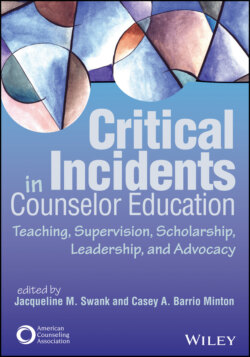Читать книгу Critical Incidents in Counselor Education - Группа авторов - Страница 80
Actions and Outcomes
ОглавлениеIt is essential that Jessica and Veronica first process their reactions to the class in general, the cohort dynamic, and specific students in the context of their cultural identities (e.g., biases, assumptions, power, and privilege). Jessica and Veronica will want to integrate aspects of the safe and supportive schools model when considering the classroom climate. They will want to consider how to optimize engaging the class in a discussion while maintaining emotional safety and managing the classroom environment. As the lead instructor, Jessica will want to consult with other faculty in the department.
It is crucial to consider complex identities and the role of privilege and oppression in the class, with particular attention to Beatrice and Amy. Jessica and Veronica hold positions of power and privilege because of their status as instructors. Jessica also has privilege as a white counselor educator, and Veronica holds membership in both privileged and marginalized groups. Beatrice, an African American female student, is part of several marginalized groups. Amy, a white female student, holds membership in both privileged and marginalized groups. At the cohort level, the instructors want to address the rupture between the students of color and white students and race relationships in general given the political and social climate. It will be vital to highlight how classroom dynamics connect to students’ advocacy work as future school counselors. Jessica and Veronica will also need to be mindful of how power and privilege impact their interactions with the class and implementation of the intervention. This is especially important because some students who identified as African American or Black expressed their frustration and disappointment at having to be the voice of Black people and their white peers appeared disinterested in interacting with them. Some white students also expressed hesitation about engaging in open dialogue about marginalized populations.
Beatrice’s reaction to the video was passionate. She expressed her frustration in an open, engaged, and respectful manner. However, Amy’s mental and physical disengagement from the discussion is most concerning. Her actions run counter to several dispositions the program considers essential for student success. Amy’s actions may indicate a lack of integrity, self-awareness, sensitivity to individual differences and respect for diversity, and adherence to the ACA Code of Ethics (ACA, 2014) and an inability to accept and make use of feedback. Amy’s actions can create more harm within the cohort if they are not addressed or it appears that the instructors are excusing or ignoring her behaviors.
Jessica decided to consult other faculty to determine whether Amy’s behavior was an isolated incident or whether Amy consistently disengaged from class discussions, especially those related to multiculturalism. Reports from faculty were mixed. One faculty member reported that Amy was more reserved in class than other students but did not come across as disengaged or disrespectful. Another faculty member shared that Amy tended to be more disengaged when topics related to multiculturalism and social justice were discussed. He recalled a class session in which Amy walked out while several students of color were presenting on school counselors working with students who were undocumented. He did not think anything of it because it was not unusual for students to take breaks throughout the 3-hour class, but he noted that Amy did not participate in the discussion following the presentation. Both faculty members also reported an underlying tension in the class, and they observed students self-segregating. Based on this feedback, Jessica invited Amy to an individual meeting to discuss concerns related to her reaction to multicultural and social justice issues and her closed-off behavior in class.
Jessica and Veronica were concerned that the cohort rupture would impact how the group continued with internship, in which there would be more discussion of the MSJCC. They put aside course content to facilitate the final class session as a continued discussion of cultural climate. At the start of the class, Jessica and Veronica established ground rules for respectful dialogue and reviewed the ACA Code of Ethics (ACA, 2014), the ASCA School Counselor Professional Standards and Competencies (ASCA, 2019), and the MSJCC (Ratts et al., 2016).
Jessica used a fishbowl approach to facilitate a conversation about race relations, cohort dynamics, and work as a school counselor. Jessica asked for six volunteers to sit in the middle of the classroom and discuss the topics at hand. The group was mixed evenly with students of color and white students. The intervention also called for six observers of the discussion and seven observers of the intervention at large. The majority of class time was spent addressing unanswered questions and exploring ways to move forward as a cohort and as future school counselors. The last 20 minutes of the class were used to wrap up the intervention and express unanswered concerns before the students left their last class as a cohort.
Although there were still some unresolved issues within the cohort, the students were willing to address them overtly and engage in a productive discussion. In addition, Amy was open to meeting individually and listening to feedback, and she processed insecurities regarding her multicultural awareness. As the students progressed in their respective internship groups, they continued exploring their cultural heritage and the impact their cultural identities had on their colleagues and themselves.
